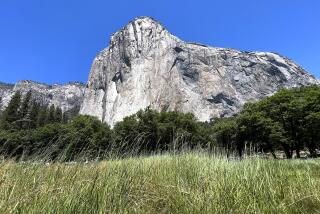A Burning Policy Issue
- Share via
Last December, investigators from the Interior and Agriculture departments generally upheld the concept of allowing natural fires to burn themselves out in wilderness areas. Fires should be fought in cases where the social and economic effects are unacceptable, the team said in its review of federal firefighting policy following last summer’s blazes in Yellowstone National Park. But the report urged an increase in the number of deliberately-set burns in parks and wilderness areas to rid them of underbrush and other material that could create dangerous fire potential and interrupt the biological evolution of the forests.
Now, however, the secretaries of Interior and Agriculture have put into place a strict fire-control plan for parks and wilderness areas. No controlled burns will be started until the agencies overhaul firefighting management programs. Natural fires will be fought at once. “If a fire occurs at Yellowstone, it will be fought immediately and put out,” a National Park Service official said. The edict endorses the old natural-burn policy in theory, but prevents it from being carried out--even after the present ban is lifted--unless a senior federal official at the scene certifies in writing daily that resources are available to guarantee the fire will not get out of control.
A crucial test of the policy will be how long it takes the new fire management programs to evolve. Then, it remains to be seen how often park or wilderness officials dare to guarantee that a natural fire can be put out, or can stretch their budgets by having sufficient firefighters on hand for controlled burns. As Stephen J. Pyne writes in his excellent book “Fire on the Rim,” implementing such a program demands a heavy investment of time, resources and personnel. “It originates out of the belief that the positive reintroduction of fire into natural systems is essential for wilderness management,” said Pyne, an Arizona State professor who worked 15 years as a seasonal firefighter at the Grand Canyon. “It requires a sustained commitment, a political will.” In the past, such will often was lacking.
Clearly the policy is yielding to political pressures as much as responding to resource management objectives. Western members of Congress were outraged last summer when park and forest officials supposedly let the Yellowstone-area fires burn at will. They threatened that heads would roll and demanded an end to the so-called let-it-burn policy. In fact, most of the damage was caused by wildfires that were fought as soon as they were discovered. Drought, weather conditions at the time and the natural buildup of fire fuel over the years provided a combination that overwhelmed fire teams. If the new fire-control policy had been in force last summer, it probably would have had very little dampening effect on the Yellowstone fires.
Fire-management programs probably should be overhauled and modernized. But the Park Service and U.S. Forest Service should return to a natural-burn and controlled-burn policy as soon as possible. Otherwise, the continued accumulation of fire material on forest floors will become tinder for more Yellowstone-type fires that overwhelm any control effort.
More to Read
Sign up for Essential California
The most important California stories and recommendations in your inbox every morning.
You may occasionally receive promotional content from the Los Angeles Times.













